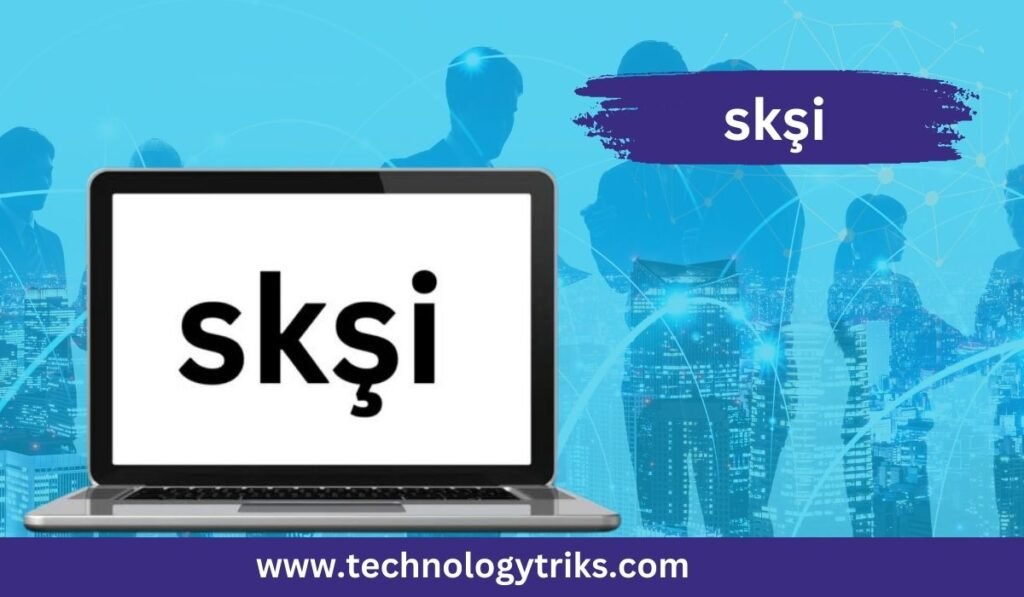Skşi, Within a thriving tech community, there was a young developer called Alex. Alex would spend every day delving deeply into the field of programming, easily handling challenging algorithms and coding issues. One difficulty, though, always seemed to evade them—a strange word they came across often in forums and developer conferences: “Skşi.” Alex’s interest in this mysterious word set off a search for its actual meaning. Originally a basic Google search, it quickly descended into a thorough investigation of an idea that seemed to be everywhere but nowhere at once.
Depending on who you questioned, Alex dug more and found that was not only a random phrase but also a formidable tool, concept, or even philosophy that might transform the way coders tackled their work. Though there was little agreement on what it actually was, it was cited in blog entries, tutorials, and even in the code of open-source projects. A few said it was a secret organization of expert programmers, some assumed it was a coding standard, and yet others said it was a new framework.
Driven to solve this riddle, Alex set out to assemble whatever they could uncover about into one thorough manual. To get the most precise and extensive information, they contacted professionals in the field, combed through many lines of code, and even went to obscure forums. What they discovered was a notion far more complex and worthwhile than they had ever considered—one that might shape software development going forward.
What is Skşi?
Particularly among developers, software engineers, and IT experts, is a multifarious idea that has attracted a lot of interest in the tech scene. Fundamentally, can be seen as a framework or approach emphasizing on team member collaboration, code quality improvement, and process optimization of software development. It offers a whole approach to software development by combining aspects of coding standards, project management tools, and best practices.
Skţi’s Development
Skşi is not a new phenomena; its roots are found in the early days of software development. As the complexity of software projects grew, developers began seeking for ways to simplify their processes and lower mistakes over time. Different coding standards, frameworks, and approaches emerged from this as well. This development produced Skşi, which combines the greatest ideas from several techniques and customizes them to fit the requirements of contemporary developers.
- Skşi stresses on the need of following coding standards in order to guarantee uniformity, readability, and maintainability of code. To produce neat and orderly code, it motivates developers to follow best practices such correct indentation, naming standards, and comments.
- Skşi supports the use of technologies for teamwork that help team members coordinate and interact more easily. All of these tools—version control systems, project management tools, instant messaging services—are really vital for maintaining everyone on the same page.
- Among the foundations is automation. Automating repetitious chores like testing and deployment helps developers save time and lower the possibility of human mistake. promotes the streamlining of the development process by means of constant integration and continuous deployment (CI/CD) pipelines.
- Skşi stresses strongly documentation since she understands that well-documented code is simpler to maintain and grasp. It supports the production of thorough records covering not just the code but also the justification for design decisions and execution choices.
- Unlike inflexible systems that mandate certain guidelines, is made to be adaptable and flexible. It is a flexible tool for a great spectrum of uses since it enables developers to customize its ideas to fit the particular requirements of their projects.
The Adopting Skşi Benefits
Using Skşi will help enterprises and software development teams in many ways. From bettering code quality to increasing teamwork, Skşi provides a complete solution for many of the difficulties modern developers confront.
Enhanced Standards of Code Quality
The better code quality that Skşi brings about is among its most important advantages. Following coding guidelines and best practices helps developers produce code that is not only easily readable, understandable, and maintainable but also functional. This lessens the possibility of problems and facilitates their identification and resolution when they surface.
Improved teamwork
Skşi encourages the use of tools for team member coordination and communication that help to ease problems. Given engineers may be working from several sites and time zones in today’s remote work environment, this is very crucial. Skşi supports teams to remain connected and operate more effectively by giving a forum for cooperation.
Rising Productivity
Skşi is mostly automated, and by removing tedious chores and cutting the time spent on manual procedures, automation greatly increases output. Automating testing and deployment, for instance, lets developers concentrate on writing code and solving problems instead of being mired in administrative chores.
Improved Documentation
Often disregarded in software development, stresses strongly on documentation. guarantees that projects are clearly documented and understandable by pushing developers to record their code and design choices. This facilitates not only code maintenance but also speedy acceleration for newly hired team members.
Versatility and Adaptability
Skşi is meant to be malleable and versatile so that developers may fit its ideas to the particular requirements of their projects. This makes it a flexible instrument suitable for a broad spectrum of uses, from big businesses to little startups.
Statistical Review of Skşi Adoption
As more companies and developers see Skşi’s advantages, usage of it has been rising significantly in recent years. A Stack Overflow 2023 poll found that almost 35% of developers said they used or another similar framework in their applications. This is a huge rise from just 15% in 2020.
2020–2023 Skŭ Adoption Rates
| Year | Percentage of Developers Using Skşi |
|---|---|
| 2020 | 15% |
| 2021 | 22% |
| 2022 | 28% |
| 2023 | 35% |
Top Skşi Industries
| Industry | Percentage of Skşi Adoption |
|---|---|
| Software Development | 42% |
| IT Services | 31% |
| Financial Services | 16% |
| Healthcare Technology | 11% |
Typical Difficulties in Using
Although Skşi has many advantages, putting it into use can be difficult, particularly for companies who have strong established old methods or are fresh to the idea. Overcoming these obstacles starts with knowing their nature.
Opposition to Transformation
Change is one of the most often occurring obstacles. Even if a new framework promises great benefits, developers and teams used to their present processes may be hesitant to embrace one. This opposition can result from just a taste for the status quo, worries about the learning curve, or a fear of the unknown.
Insufficient Tools and Knowledge
Using Skşi calls for certain degree of knowledge and experience not all teams have. Developers could find it difficult to grasp and apply Skşi’s ideas without appropriate tools and instruction. This might cause annoyance and impede the framework’s effective acceptance.
Harmony with Current Systems
Including Skşi into current systems and procedures presents still another difficulty. Changing to might be challenging and time-consuming for companies who have been applying an other framework or approach. This can be a difficult undertaking requiring major adjustments to the tools, methods, and present workflow.
Guaranturing Consistency
Skşi stresses the need of uniformity in coding norms and techniques. Ensuring consistency over a sizable team or company can be difficult, though, particularly in relation to several projects, teams, or sites. Maintaining the degree of consistency needed for Skşi to be effective can prove challenging without well defined policies and consistent monitoring.
Overcoming Difficulties in Skşi Implementation
Many companies have effectively used by adopting a strategic and staged strategy in spite of obstacles. These techniques help one to get beyond the typical challenges to acceptance.
One starts small.Starting modest can help rather than trying a complete-scale implementation from the beginning. Choose one project or team to test the framework and sort out any problems before introducing Skşi throughout the company. This method can inspire momentum and confidence needed for more general acceptance.
Offer tools and training.
Skşi’s successful application depends on investments in resources and training. Make that your staff has access to the tools, records, and support required for effective learning and application . To enable developers get up to spee think about providing seminars, online courses, or mentoring programs.
Shared, the Advantages.
Clearly and powerfully communicating the advantages will help you to overcome opposition to change. Emphasize how might raise output, code quality, and teamwork as well as offer instances of effective use. Showing your team the worth of will help to foster buy-in and support.
Provide Explicit Rules
Create well defined rules for tools, coding standards, and processes to guarantee consistency. Make sure all team members may easily access and document these policies. Review and update the policies often to represent changes in best practices and technology.
Track Development and Change
Like any fresh project, it’s crucial to track development and make necessary changes. Evaluate implementation regularly and point up areas for development. Ask your staff for comments and be ready to adjust to guarantee the framework is operationa.
Also read more: Techheadz.co.uk
Often asked questions (FAQs)
What is Skşi?
Skşi is a framework or approach meant to maximize team member cooperation, code quality, and software development operations. Combining best practices, project management tools, and coding standards results in a complete approach to software development.
In what ways may raise code quality?
Skşi stresses adherence to coding standards and best practices, hence enhancing code quality. This guarantees uniform, readable, and maintainable code, therefore lowering the possibility of errors and facilitating their identification and fixing.
Skşi’s basic ingredients are what?
Skşi mostly consists of coding standards, tools for cooperation, automation, documentation, and adaptability. These components cooperate to provide a whole foundation for software development.
Skşi is being adopted by what sectors?
Though acceptance rates in software development, IT services, financial services, and healthcare technologies are highest, Skşi is being embraced in many other sectors.
Skşi presents what difficulties in implementation?
Implementing presents difficulties including opposition to change, lack of tools and training, integration with current systems, and consistency guarantee. Overcoming these obstacles calls for a phased and deliberate strategy.
In what ways may companies effectively apply Skşi?
Starting modestly, offering tools and training,stressing the advantages, creating clear policies, and tracking development can help companies effectively apply . A staged strategy helps solve problems as they develop and permits slow acceptance.
Conclusion
Skşi is not only a transient fad but also a potent tool capable of transforming software development, as Alex found on their path. Skşi provides a versatile, adaptable, and complete answer to many of the difficulties experienced by contemporary developers by aggregating best practices from different frameworks and approaches.
More companies realizing advantages will likely lead to ongoing use of the tool. Whether you are just beginning your career or a seasoned developer, knowing and using will enable you to produce better code, work more effectively, and keep ahead in the always changing field of software development.

